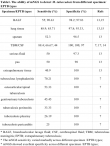The role of metagenomic next-generation sequencing to diagnose HIV-TB coinfection: a promising technology
Abstract
The human immunodeficiency virus (HIV) pandemic has caused a resurgence of tuberculosis (TB), resulting in increased morbidity and mortality. Meanwhile, HIV-TB coinfection lead to diagnostic difficulty. Sputum smear microscopy, mycobacterial culture, and the GeneXpert MTB/RIF assay (Xpert) are generally endorsed to detect M. tuberculosis in HIV-TB coinfection. However, these methods cannot diagnose TB in an accurate and timely manner, which increases the rates of HIV-related morbidity and mortality in TB patients. Hence, there is a considerable need for a better diagnostic tool for HIV-TB coinfected individuals. Metagenomic next-generation sequencing (mNGS) is a novel detecting platform which is widely used in infectious disease, antimicrobial resistance and the microbiome and human host gene expression. Herein, we first summarized its diagnostic advantages in infectious disease. Then we assessed the efficiency of mNGS in the detection of Mycobacterium tuberculosis (M. tuberculosis) in different specimens and a few cases of in HIV-TB coinfection. We concluded that mNGS is an acceptable diagnostic method in HIV-TB coinfection although limited research is available.


